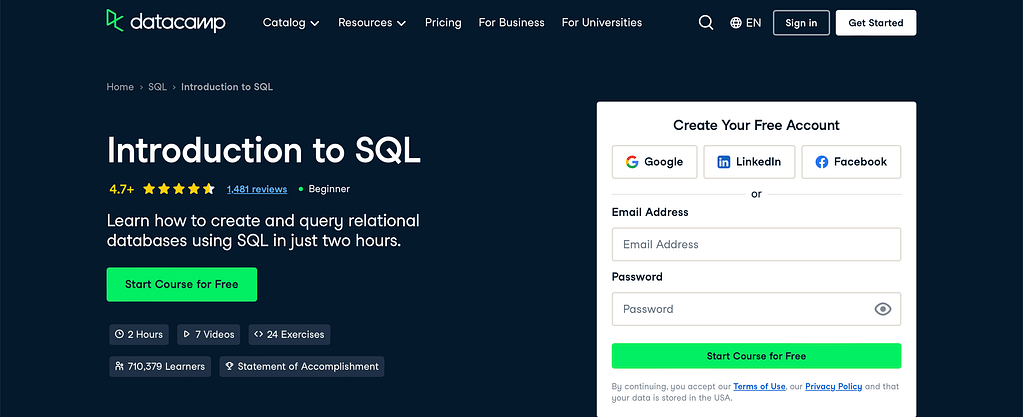
Hello, fellow education enthusiasts and aspiring coders!
Today, I’m taking a break from my usual principal duties to start these exciting updates on my journey to become a software developer. I’ve just completed the first lesson of “Introduction to SQL” course on DataCamp, and let me tell you, it’s been quite the ride! Who knew that managing data could be as thrilling as managing a school? (Okay, maybe not quite as thrilling, but close!)
Let’s dive into the world of SQL – where data is our new student body, and queries are our lesson plans. Here’s what I’ve learned:
The Basics of SQL
1. SQL: The New School Language
Remember how we have a structure in our school? Well, SQL (Structured Query Language) is like that, but for data!
- Relational Database: Think of it as our school, with each grade being a table.
- Row/Record: Like a student in our school registry.
- Column/Field: The different pieces of information we keep about each student.
2. Why Databases Beat Spreadsheets (Sorry, Excel!)
- Scalability: Imagine fitting all the students in the district into one classroom. Databases handle that with ease!
- Data Integrity: No more “the dog ate my homework” excuses for data errors.
- Multi-User Access: Like having multiple teachers grading papers simultaneously.
- Complex Queries: It’s like being able to instantly know which students like both math and pizza!
3. Queries: The New Pop Quiz
A query is like asking your class a question, but instead of raising hands, you get data!
Naming Conventions
4. Naming Tables: The New Classroom Labels
- Use lowercase: no shouting in the data hallways!
- No spaces allowed: use_underscores_instead.
- Plural nouns: Because we’re dealing with groups. (students, not student)
5. Naming Fields: The New Name Tags
- Lowercase and underscores: student_name, not “Student Name”.
- Singular nouns: We’re labeling one piece of info at a time.
- Keep ’em unique: Just like no two students have the same student ID!
Data Structure and Types
6. Unique Identifiers: The New Student IDs
Every student needs a unique ID, and so does every piece of data!
7. SQL Data Types: The New Subject Categories
- VARCHAR: For text, like student names.
- INT: For whole numbers, like age.
- NUMERIC: For precise numbers, like GPA.
8. Database Schemas: The New School Blueprint
It’s like the architectural plan of our data school!
SQL Commands and Concepts
9. SELECT, FROM, and *
SELECT student_name, grade
FROM students;It’s like saying, “Hey, give me the names and grades of all students!”
10. Aliasing with AS: The New Nicknames
SELECT student_name AS name, grade AS score
FROM students;Because sometimes “grade” sounds too scary, so we call it “score”!
11. DISTINCT: The New “Raise Your Hand If…”
SELECT DISTINCT grade
FROM students;It’s like asking, “What different grades do we have in this school?”
12. Views: The New “Teacher’s Perspective”
CREATE VIEW honor_roll AS
SELECT student_name, grade
FROM students
WHERE grade > 90;It’s our special list that we can quickly reference anytime!
13. PostgreSQL vs T-SQL: The New “Public School vs. Private School” Debate
Both teach SQL, but with their own special flavors!
PostgreSQL, the “public school” option, is open-source and free for all, welcoming developers with open arms. On the flip side, T-SQL, our “private school” contender, comes with a hefty price tag but boasts some exclusive features. Just like choosing a school, it’s all about weighing the pros and cons. Do you go for the community-driven PostgreSQL with its flexible approach, or the structured, Microsoft-backed T-SQL?
14. LIMIT: The New “Front Row Only”
SELECT *
FROM students
LIMIT 10;When you only want to look at the first few students in the class.

The Data Report Card
And now, for our “Data Report Card”:
| CONCEPT | DESCRIPTION | EXAMPLE |
|---|---|---|
| Relational Database | Our data school | – |
| Row/Record | A student in our data class | – |
| Column/Field | A fact about our data student | – |
| Query | Asking our data a question | SELECT * FROM students; |
| Table Naming | How we label our data classrooms | students |
| Field Naming | How we label our data cubbies | student_name |
| Unique Identifiers | Data student IDs | student_id |
| SQL Data Types | Data subject categories | VARCHAR(255), INT, NUMERIC(10, 2) |
| Database Schemas | Our data school blueprint | – |
| SELECT, FROM, * | Data roll call | SELECT student_name FROM students; |
| Aliasing with AS | Data nicknames | SELECT student_name AS name FROM students; |
| DISTINCT | Data raised hands | SELECT DISTINCT grade FROM students; |
| Views | Data honor rolls | CREATE VIEW top_students AS SELECT ...; |
| PostgreSQL vs T-SQL | Data school types | – |
| LIMIT | Data front row | SELECT * FROM students LIMIT 10; |
Conclusion
Whew! Who knew that becoming a software developer would make me feel like a student all over again? But I must say, it’s incredibly exciting to see how the skills we use in education management can translate into the world of data and programming.
Stay tuned for more adventures as I continue my journey from managing students to managing databases. Next up: trying to convince the school board that “SELECT * FROM budget WHERE money > 0” is a valid financial strategy!
Until next time, keep learning and stay SQL!
Your Principal-turned-Programmer,